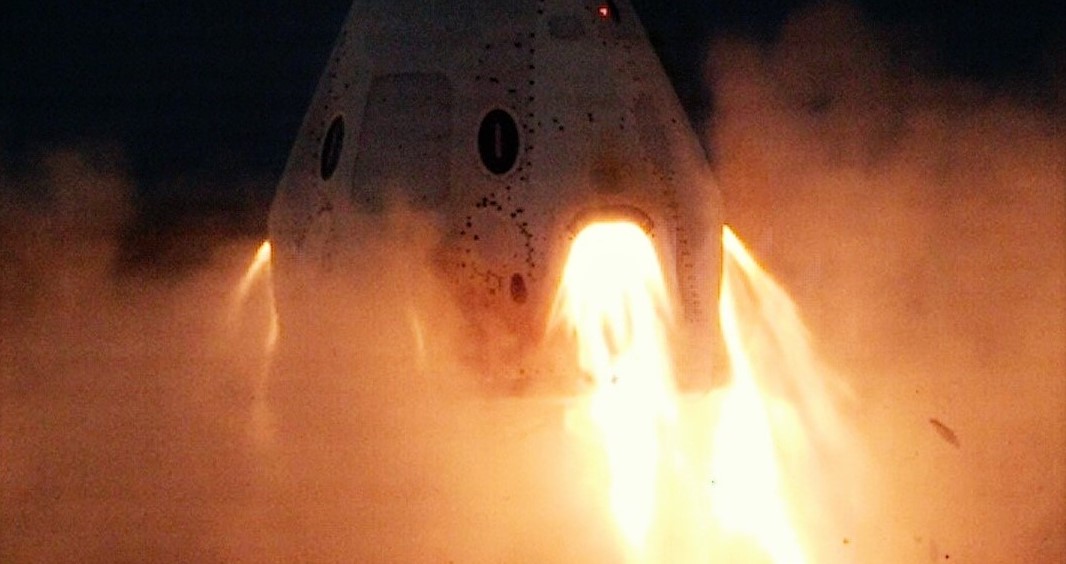
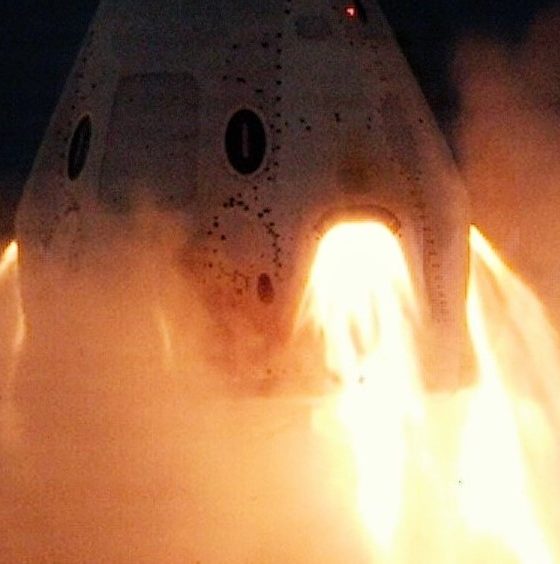
News
SpaceX fires up redesigned Crew Dragon as NASA reveals SuperDraco thruster “flaps”
On November 13th, SpaceX revealed that a planned static fire test of a Crew Dragon’s powerful abort thrusters was completed without issue, a strong sign that the company has successfully redesigned the spacecraft to prevent a catastrophic April 2019 explosion from reoccurring.
Pending a far more extensive analysis, Wednesday’s static fire should leave SpaceX on track to perform Crew Dragon’s next major flight test before the end of 2019.
In an unexpected flourish of transparency, SpaceX and NASA published photos of the Crew Dragon capsule’s static fire test just a few hours after it was completed, an excellent sign that the ‘quick-look’ data analysis immediately following the test was extremely positive. Spaceflight Now was first to visually confirm that the test had occurred, publishing a photo that revealed a whitish cloud of smoke produced by the static fire around 3:15 pm EST (20:15 UTC).
Had a failure similar to the April 2019 explosion occurred, that cloud would have likely been tinged red by unburnt dinitrogen tetroxide (NTO) oxidizer, and the different appearance of November 13th’s exhaust cloud was seen as the first tentative sign that this static fire had gone more successfully.
Alongside photos of the SuperDraco thruster test published by NASA and SpaceX shortly after its conclusion, SpaceX confirmed that the test was completed without issue. Regardless of whether everything performed exactly as intended, this means that factory-fresh Crew Dragon capsule C205 made it through the test unscathed, likely securing SpaceX and NASA a large volume of uninterrupted telemetry data, as well as the hardware itself.
Just hours after C205’s static fire was completed, NASA published a detailed update, confirming that the tests were finished without any immediately apparent issues.
NASA described the test in much more detail than SpaceX, noting that it began with the ignition of two of Crew Dragon’s 16 Draco maneuvering thrusters, each performing two one-second burns. C205’s eight SuperDraco abort thrusters subsequently ignited and burned for a total of ~9 seconds to simulate required abort performance, followed by the reignition of two Draco thrusters immediately after SuperDraco cutoff.
Each capable of producing several dozen pounds of thrust, both Crew and Cargo Dragon use Draco thrusters to orient themselves in orbit, rendezvous with the International Space Station, and lower their orbits to reenter Earth’s atmosphere. Crew Dragon’s Draco thrusters are also designed to control its attitude during abort scenarios, stabilizing and flipping the spacecraft to prevent a loss of control and ensure proper orientation during emergency parachute deployment. The Draco firings during Crew Dragon’s November 13th static fire were meant to simulate that additional use-case.
Aside from verifying that SpaceX has successfully redesigned Crew Dragon to mitigate the failure mode that caused capsule C201’s catastrophic explosion in April 2019, the Draco static fires specifically mirrored the burns Crew Dragon C205 will need to perform to successfully complete its In-Flight Abort (IFA) test. As noted by NASA and SpaceX, with the static fire complete, both teams will now comb through the data produced, inspect Crew Dragon to verify its health and the performance of its redesigned high-flow pressurization system, and perform any necessary refurbishment.
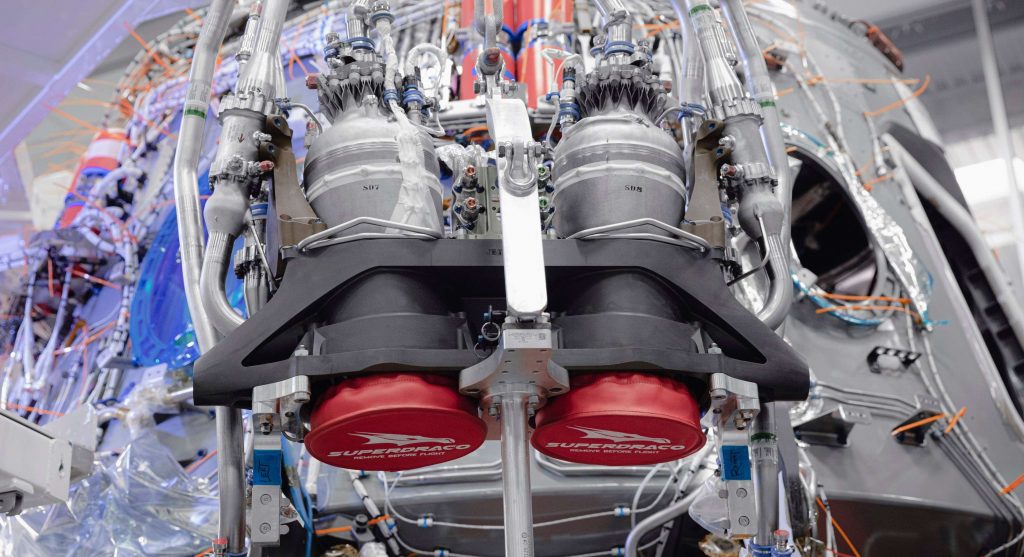
SuperDraco’s mystery “flaps”
NASA’s post on Crew Dragon’s static fire revealed another thoroughly intriguing detail: the SpaceX spacecraft’s SuperDraco thrusters apparently have flaps! A bit of retroactive speculation suggests that SuperDracos are closed out with plugs of some sort to create a seal against the environment before Crew Dragon is rolled out to the launch pad. Perhaps, in the event of a SuperDraco ignition, SpaceX included actuating flaps as a method of resealing those thrusters prior to splashdown in the Atlantic Ocean.
“Immediately after the SuperDracos shut down, two Dracos thrusters fired and all eight SuperDraco flaps closed, mimicking the sequence required to reorient the spacecraft in-flight to a parachute deploy attitude and close the flaps prior to reentry. The full sequence, from SuperDraco startup to flap closure, spanned approximately 70 seconds.”
NASA, November 13th, 2019
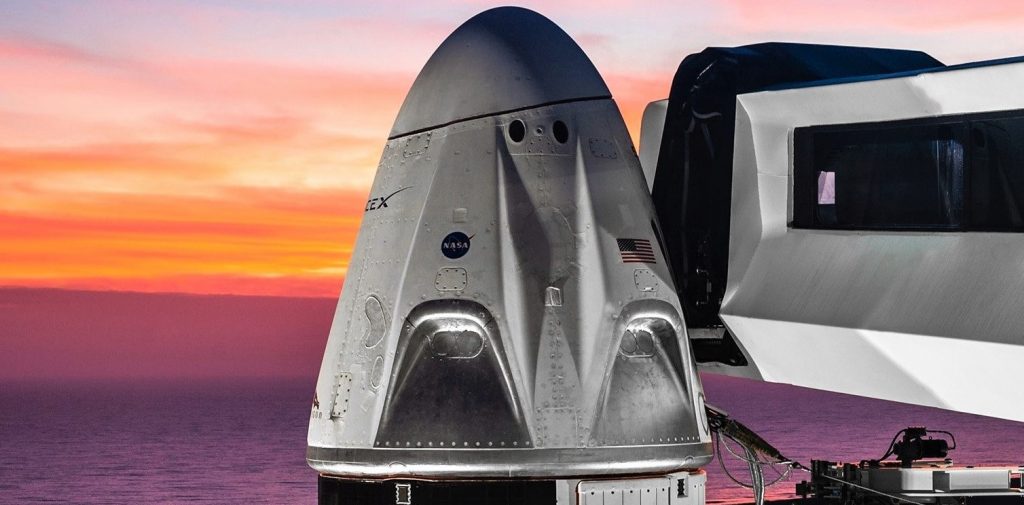
Given that the obvious utility of those flaps appears to be extremely limited and their associated actuators have to survive the 9+ consecutive seconds of hellish conditions in the event of an actual abort, it seems like an excessively complicated system to include on Crew Dragon. Nevertheless, the ability to guarantee that SuperDracos are water-sealed before splashdown would almost without a doubt make Crew Dragon far easier to refurbish and reuse.
The SuperDraco flaps may also be a holdover from before propulsive Crew Dragon landings were canceled, although the use-cases for such a system still remain unclear. The flaps’ raison d’etre could even be as simple as preventing water intrusion that might otherwise cause Dragon to sink after splashdown.
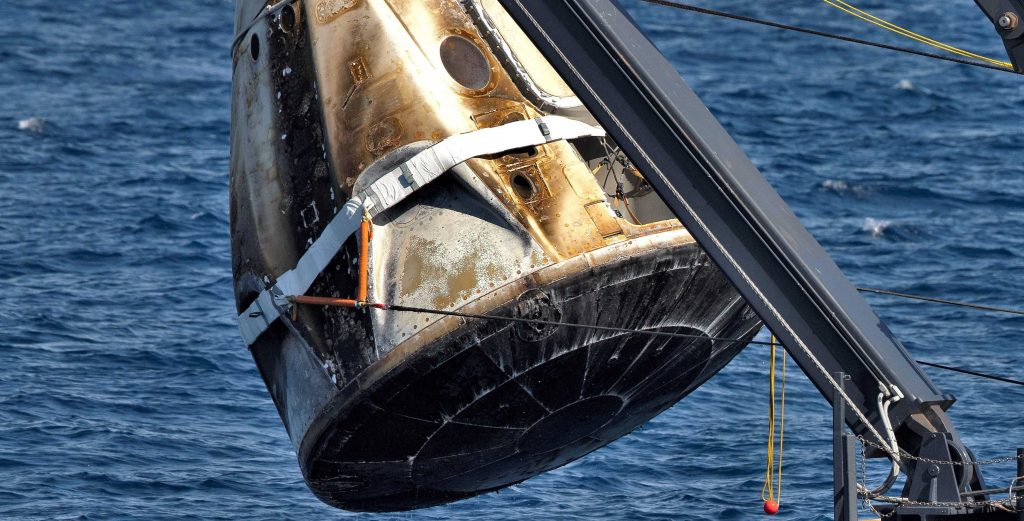
Regardless of why they exist, NASA indicates that SpaceX’s November 13th static fire proved that they worked exactly as expected, closing soon after the simulated abort burn to seal Crew Dragon against water intrusion. If NASA and SpaceX’s deep-dive inspections and data analysis uncover no red flags, it’s extremely likely that SpaceX will able to launch C205 for its In-Flight Abort test some 4-8 weeks from now.
If the IFA also goes as planned, Crew Dragon could be ready for its inaugural NASA astronaut launch as early as February or March 2020.
Check out Teslarati’s Marketplace! We offer Tesla accessories, including for the Tesla Cybertruck and Tesla Model 3.

News
Tesla China delivery centers look packed as 2025 comes to a close
Needless to say, it appears that Tesla China seems intent on ending 2025 on a strong note.

Tesla’s delivery centers in China seem to be absolutely packed as the final days of 2025 wind down, with photos on social media showing delivery locations being filled wall-to-wall with vehicles waiting for their new owners.
Needless to say, it appears that Tesla China seems intent on ending 2025 on a strong note.
Full delivery center hints at year-end demand surge
A recent image from a Chinese delivery center posted by industry watcher @Tslachan on X revealed rows upon rows of freshly prepared Model Y and Model 3 units, some of which were adorned with red bows and teddy bears. Some customers also seem to be looking over their vehicles with Tesla delivery staff.
The images hint at a strong year-end push to clear inventory and deliver as many vehicles as possible. Interestingly enough, several Model Y L vehicles could be seen in the photos, hinting at the demand for the extended wheelbase-six seat variant of the best-selling all-electric crossover.
Strong demand in China
Consumer demand for the Model Y and Model 3 in China seems to be quite notable. This could be inferred from the estimated delivery dates for the Model 3 and Model Y, which have been extended to February 2026 for several variants. Apart from this, the Model Y and Model 3 also continue to rank well in China’s premium EV segment.
From January to November alone, the Model Y took China’s number one spot in the RMB 200,000-RMB 300,000 segment for electric vehicles, selling 359,463 units. The Model 3 sedan took third place, selling 172,392. This is quite impressive considering that both the Model Y and Model 3 are still priced at a premium compared to some of their rivals, such as the Xiaomi SU7 and YU7.
With delivery centers in December being quite busy, it does seem like Tesla China will end the year on a strong note once more.
News
Tesla Giga Berlin draws “red line” over IG Metall union’s 35-hour week demands
Factory manager André Thierig has drawn a “red line” against reducing Giga Berlin’s workweek to 35 hours, while highlighting that Tesla has actually increased its workers’ salaries more substantially than other carmakers in the country.

Tesla Giga Berlin has found itself in a new labor dispute in Germany, where union IG Metall is pushing for adoption of a collective agreement to boost wages and implement changes, such as a 35-hour workweek.
In a comment, Giga Berlin manager André Thierig drew a “red line” against reducing Giga Berlin’s workweek to 35 hours, while highlighting that Tesla has actually increased its workers’ salaries more substantially than other carmakers in the country.
Tesla factory manager’s “red line”
Tesla Germany is expected to hold a works council election in 2026, which André Thierig considers very important. As per the Giga Berlin plant manager, Giga Berlin’s plant expansion plans might be put on hold if the election favors the union. He also spoke against some of the changes that IG Metall is seeking to implement in the factory, like a 35-hour week, as noted in an rbb24 report.
“The discussion about a 35-hour week is a red line for me. We will not cross it,” Theirig said.
“(The election) will determine whether we can continue our successful path in the future in an independent, flexible, and unbureaucratic manner. Personally, I cannot imagine that the decision-makers in the USA will continue to push ahead with the factory expansion if the election results favor IG Metall.”
Giga Berlin’s wage increase
IG Metall district manager Jan Otto told the German news agency DPA that without a collective agreement, Tesla’s wages remain significantly below levels at other German car factories. He noted the company excuses this by referencing its lowest pay grade, but added: “The two lowest pay grades are not even used in car factories.”
In response, Tesla noted that it has raised the wages of Gigafactory Berlin’s workers more than their German competitors. Thierig noted that with a collective agreement, Giga Berlin’s workers would have seen a 2% wage increase this year. But thanks to Tesla not being unionized, Gigafactory Berlin workers were able to receive a 4% increase, as noted in a CarUp report.
“There was a wage increase of 2% this year in the current collective agreement. Because we are in a different economic situation than the industry as a whole, we were able to double the wages – by 4%. Since production started, this corresponds to a wage increase of more than 25% in less than four years,” Thierig stated.
News
Tesla is seeing a lot of momentum from young Koreans in their 20s-30s: report
From January to November, young buyers purchased over 21,000 Teslas, putting it far ahead of fellow imported rivals like BMW and Mercedes-Benz.

Tesla has captured the hearts of South Korea’s 20s-30s demographic, emerging as the group’s top-selling imported car brand in 2025. From January to November, young buyers purchased over 21,000 Teslas, putting it far ahead of fellow imported rivals like BMW and Mercedes-Benz.
Industry experts cited by The Economist attributed this “Tesla frenzy” to fandom culture, where buyers prioritize the brand over traditional car attributes, similar to snapping up the latest iPhone.
Model Y dominates among young buyers
Data from the Korea Imported Automobile Association showed that Tesla sold 21,757 vehicles to the 20s-30s demographic through November, compared to BMW’s 13,666 and Mercedes-Benz’s 6,983. The Model Y led the list overwhelmingly, with variants like the standard and Long Range models topping purchases for both young men and women.
Young men bought around 16,000 Teslas, mostly Model Y (over 15,000 units), followed by Model 3. Young women followed a similar pattern, favoring Model Y (3,888 units) and Model 3 (1,083 units). The Cybertruck saw minimal sales in this group.
The Model Y’s appeal lies in its family-friendly SUV design, 400-500 km range, quick acceleration, and spacious cargo, which is ideal for commuting and leisure. The Model 3, on the other hand, serves as an accessible entry point with lower pricing, which is valuable considering the country’s EV subsidies.
The Tesla boom
Experts described Tesla’s popularity as “fandom culture,” where young buyers embrace the brand despite criticisms from skeptics. Professor Lee Ho-geun called Tesla a “typical early adopter brand,” comparing purchases to iPhones.
Professor Kim Pil-soo noted that young people view Tesla more as a gadget than a car, and they are likely drawn by marketing, subsidies, and perceived value. They also tend to overlook news of numerous recalls, which are mostly over-the-air software updates, and controversies tied to the company.
Tesla’s position as Korea’s top import for 2025 seems secured. As noted by the publication, Tesla’s December sales figures have not been reported yet, but market analysts have suggested that Tesla has all but secured the top spot among the country’s imported cars this year.








